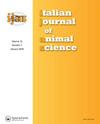Relationship between growing pig’s housing conditions, behaviours, lesions and health issues under Italian farming system
IF 2.2
3区 农林科学
Q1 AGRICULTURE, DAIRY & ANIMAL SCIENCE
引用次数: 0
Abstract
Low space availability, high temperatures and a barren environment may contribute to the occurrence of abnormal behaviours and lesions in intensive pig farming. The present study evaluated the housing conditions (HCs), that influence behavioural measures (BMs), and lesion and health measures (LHMs) in growing pigs reared in an Italian farming system. Data collection was carried out on two groups of pigs in each farm (Farm A and Farm B), tail docked (DT) and tail undocked (UT). The HCs measured were dry and wet bulb temperature, light, humidity, air quality, average body weight, pen level of cleanliness, space, and feeder front allowance. Light intensity was negatively associated with positive behaviour (coefficient: −0.01; p < 0.001), while the length of the feeder front was positively associated with the proportion of pigs exploring the pen (coefficient: 65.18; p = 0.04). Tail lesion score index (LSI) increased with an increased frequency of negative behaviour (coefficient: 8.05; p < 0.01), increased light intensity (coefficient: 0.29; p < 0.001) and increased proportion of CO2 (coefficient: 498.31; p < 0.001), while it decreased with the average body weight of the pen (coefficient: −4.04; p < 0.001) and the space allowance (coefficient: −198.93; p < 0.001). Finally, UT pigs showed a greater (p < 0.001) tail LSI than DT pigs (126.8 ± 5.71 and 78.5 ± 9.11, respectively for UT and DT pigs). The present study improved the understanding of the effects of HCs, including tail docking, on welfare parameters of growing pigs.意大利养殖系统下生长猪的住房条件、行为、病变和健康问题之间的关系
在集约化养猪业中,低可用空间、高温和贫瘠的环境可能导致异常行为和病变的发生。本研究评估了在意大利养殖系统中饲养的生猪的住房条件(hc),影响行为测量(BMs)以及损伤和健康测量(LHMs)。每个猪场(A场和B场)的两组猪进行数据收集,分别是尾断(DT)和尾未断(UT)。测量的HCs包括干湿球温度、光照、湿度、空气质量、平均体重、围栏清洁度、空间和馈线前部余量。光照强度与阳性行为呈负相关(系数:- 0.01;P < 0.001),而喂食器前端长度与猪探索猪圈的比例呈正相关(系数:65.18;P = 0.04)。尾部病变评分指数(LSI)随不良行为频次的增加而升高(系数:8.05;P < 0.01),光照强度增加(系数:0.29;p < 0.001), CO2比例增加(系数:498.31;P < 0.001),随着笔体平均质量的增加而降低(系数:- 4.04;P < 0.001)和空间余量(系数:−198.93;P < 0.001)。最后,UT猪的尾部LSI高于DT猪(p < 0.001)(分别为126.8±5.71和78.5±9.11)。本研究提高了对hc(包括断尾)对生长猪福利参数影响的认识。
本文章由计算机程序翻译,如有差异,请以英文原文为准。
求助全文
约1分钟内获得全文
求助全文
来源期刊

Italian Journal of Animal Science
农林科学-奶制品与动物科学
CiteScore
4.90
自引率
8.00%
发文量
141
审稿时长
18-36 weeks
期刊介绍:
The Italian Journal of Animal Science is an international peer-reviewed open access journal publishing original scientific papers, reviews and short communications on animal science, animal production and related areas. The journal welcomes submissions on the following subjects:
• Animal derived food quality and safety
• Animal genetics and breeding
• Aquaculture, poultry, companion and wildlife
• Livestock systems, management and environment
• Non-ruminants nutrition and feeding
• Production physiology and biology
• Ruminants nutrition and feeding
Announcements of congresses, presentations of universities, research institutes, books and proceedings may also be published, as well as news regarding the members of the Animal Science and Production Association (ASPA). The Association will be glad to receive proposals for your admission as an ordinary or corresponding member: please read regulations and procedures in the statute of the ASPA .
 求助内容:
求助内容: 应助结果提醒方式:
应助结果提醒方式:


